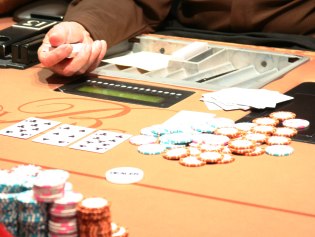Online Poker Fixed Limit Strategy Learn how to play 'Poker Fixed Limit'! This strategy is intended to define what hand to play in the initial 'fixed limit' kind of game where the stakes are always limited by a fixed value, which is a type of game that should only go to the game early with strong hands! Fixed Limit-ed Opportunities A lot of limit players tend to play extremely straightforward and predictable, failing to take advantage of situations that will earn them extra bets. It's very important to plan your bets based on how the hand likely to play out given your opponent's range. Often offered by no-limit hold'em players, there is an element of truth to some of these claims. But low stakes, fixed-limit hold'em (defined here as $4/$8 and below) is still the game for some of.
Poker Strategy Fixed Limit Definition
In a split-pot game, there are generally three reasons to raise: (1) you believe you are the only person playing for one half of the pot and have multiple people playing for the other half, leading to a situation where you can raise with impunity; (2) you think you have the best hand or best draw and are raising for value against worse hands that may call; or (3) you feel that you can get a better hand or better draw to fold. Knowing when to raise, and why, can be tricky in split-pot games.
Consider two different raises from a recent session of limit Omaha hi/lo that I played. The table could best be described as very, very tight. Raises were given far more respect than they deserved. In the first hand, I was dealt and limped into the pot after two early-position limpers. One player called behind me before the big blind checked.
The flop came down , making top set for me and giving me the low-end of a gutshot straight draw. It also put a made low on the board. As you might expect, when the action passed to me, I bet out. The player behind me folded, bringing action around to the big blind, who check-raised. She was probably the tightest player at the table. As soon as she check-raised, nobody else wanted a part of the pot. It quickly became heads-up between the two of us.
I called the raise, then raised myself when the board paired sevens on the turn with the . My opponent called, then check-called the river. I showed a full house, aces full of sevens, for high and 8-7-5-4-A for low. My opponent turned over , making three sevens for high and the nut low, 8-7-3-2-A. She also left me scratching my head. Why had she check-raised the flop?
On the flop, the big blind made the nut low, and a pair of sevens for high with no draw to speak of. At first blush, therefore, it appears that she was raising for value. However, because she has almost no chance of scooping the pot and will instead only receive half, her interest lies in building the pot as big as she can. Given the extremely tight table conditions, her check-raise is going to fold weak high draws and mediocre low draws. These are hands that either (a) she would rather see call against her nut low, or (b) she would rather have call because they have zero impact on her half of the pot. The only rationale I could come up with for the big blind's check-raise was that she was afraid of having her low counterfeited by a deuce or a trey falling on the turn or river. That will happen one time out of four, not nearly often enough to be concerned about — especially in a five-way pot!
Later on that session, the same player was involved in another pot against two opponents. I opened the betting with top two pair on a board of . I was called by one opponent before the player from the earlier hand, now on the button, made a strong raise. I had played with her long enough to realize that she wasn't raising any kind of wrap; her most likely holding was a set (given my cards, a set of eights). One early-position player called the two bets cold. I called, looking to fill up on the turn; the other player in the hand called as well.
The turn was the , a card that missed me. We all checked the action around to the button, who bet. She was called by the early-position player and the player on her right, but not by me. I folded. The river was the and brought a bet from the early-position player. That bet was raised by the player on the button's right. The button steamed for a few moments before dejectedly mucking her cards. The early-position player called. He held for the nut low and ace-high. The player on the button's right turned over for the nut low and a pair of fours for high.
If the button was steaming when the third heart hit the river and she was faced with calling two bets cold, she steamed even more when she saw the winning high hand. 'How could you raise that?' she asked the player on her right.
'Why, what did you have?' he responded.

'I had a set! I thought you made a flush.'


In this hand, it's unclear if the late-position player was raising because he thought he was the only person going low and had caught two big high hands around him (a flush and a set), or if he legitimately thought he could knock the button off of her hand. Given that he had no high hand, I'm guessing the former. But this instance clearly demonstrates that there is more than one reason to raise. Sometimes you hope a worse hand calls (or in a split-pot game, that you can trap a third player into putting extra money in the pot); sometimes you hope a better hand folds.
One of the keys to success in fixed-limit betting is to understand what a given decision — like a raise — will accomplish in a particular situation. Fixed-limit games, by design, require multiple decisions in every pot. That can lead to either a cascade of poor decisions resulting in missed wins and/or small losses, or a plethora of correct decisions and modest gains. Over the long run, each adds up in its own way.

Tags
OmahaPokerNews Strategy
Limit Texas Hold'em Guides
Limit Hold'em: Every Bet Counts
In Limit Hold'em, it's crucial to understand the importance of a single bet, and how the bet affects you and…

'I had a set! I thought you made a flush.'
In this hand, it's unclear if the late-position player was raising because he thought he was the only person going low and had caught two big high hands around him (a flush and a set), or if he legitimately thought he could knock the button off of her hand. Given that he had no high hand, I'm guessing the former. But this instance clearly demonstrates that there is more than one reason to raise. Sometimes you hope a worse hand calls (or in a split-pot game, that you can trap a third player into putting extra money in the pot); sometimes you hope a better hand folds.
One of the keys to success in fixed-limit betting is to understand what a given decision — like a raise — will accomplish in a particular situation. Fixed-limit games, by design, require multiple decisions in every pot. That can lead to either a cascade of poor decisions resulting in missed wins and/or small losses, or a plethora of correct decisions and modest gains. Over the long run, each adds up in its own way.
Tags
OmahaPokerNews Strategy
Limit Texas Hold'em Guides
Limit Hold'em: Every Bet Counts
In Limit Hold'em, it's crucial to understand the importance of a single bet, and how the bet affects you and…
5 minutes to readHow to Play Limit Texas Holdem: Set-Up and Play
Texas Hold'em is the most widely played poker variation in the world, particularly thanks to its simple setup and play.…
7 minutes to readDebunking the 2 Biggest Myths of Limit Holdem Poker
Most No-Limit players have a raging hatred of anything Limit. This hatred is typically unfounded, based on half-truths, myths and…
10 minutes to readHow to Make Money in Limit Hold'em Tournaments | Poker Strategy
OK; so you just registered for a tournament on your favorite online poker site. In the first hand you get…
6 minutes to readLimit Texas Hold'em
Fixed Limit Texas Hold'em poker is beatable but can prove tricky because you can't just call down hands due to…
40 minutes to readPoker Strategy Fixed Limit Credit Cards
How to Play Straight Draws in Limit Texas Hold'em
Straight draws are strong draws in Limit Texas Hold'em. When you flop a straight draw it's either going to be…
4 minutes to readHow to Play Short-Handed Limit Holdem
Introduction Shorthanded poker is played with six or less players at the table, making it necessary to give more action… Caesars palace casino table minimums.
Poker Strategy Fixed Limit Rules
4 minutes to readHow to Play Overcards on the Flop in Limit Holdem
Since Limit Texas Hold'em is a 'big card game', you will find yourself in many situations where all you hold…
3 minutes to read